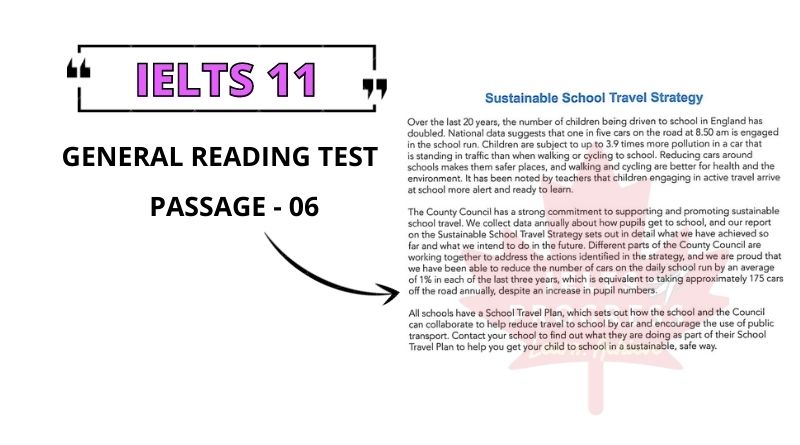IELTS General Test – Passage 06: Sustainable School Travel Strategy reading with answers explanation, location and pdf summary. This reading paragraph has been taken from our huge collection of Academic & General Training (GT) Reading practice test PDF’s.

Sustainable School Travel Strategy
Over the last 20 years, the number of children being driven to school in England has doubled. National data suggests that one in five cars on the road at 8.50 am is engaged in the school run. Children are subject to up to 3.9 times more pollution in a car that is standing in traffic than when walking or cycling to school. Reducing cars around schools makes them safer places, and walking and cycling are better for health and the environment. It has been noted by teachers that children engaging in active travel arrive at school more alert and ready to learn.
The County Council has a strong commitment to supporting and promoting sustainable school travel. We collect data annually about how pupils get to school, and our report on the Sustainable School Travel Strategy sets out in detail what we have achieved so far and what we intend to do in the future. Different parts of the County Council are working together to address the actions identified in the strategy, and we are proud that we have been able to reduce the number of cars on the daily school run by an average of 1% in each of the last three years, which is equivalent to taking approximately 175 cars off the road annually, despite an increase in pupil numbers.
All schools have a School Travel Plan, which sets out how the school and the Council can collaborate to help reduce travel to school by car and encourage the use of public transport. Contact your school to find out what they are doing as part of their School Travel Plan to help you get your child to school in a sustainable, safe way.
Questions 1-6
Do the following statements agree with the information given in the text?
In boxes 1-6 on your answer sheet, write
TRUE if the statement agrees with the information
FALSE if the statement contradicts the information
NOT GIVEN if there is no information on this
1. More children are injured when walking or cycling to school than when travelling by car.
2. Children who are driven to school are more ready to learn than those who walk or cycle.
3. Every year the Council gathers information about travel to schools.
4. The Council is disappointed with the small reduction in the number of cars taking children to school.
5. The number of children in schools has risen in recent years.
6. Parents can get help with paying for their children to travel to school by public transport.
________________
ALSO TRY:
1) IELTS 11 READING PASSAGE – THE ZEBRA’S LONG WALK ACROSS AFRICA ↗
2) IELTS 11 READING PASSAGE – HILTON LABORATORY ↗
3) IELTS 11 READING PASSAGE – GZJ TRAVEL: RECRUITMENT INFO ↗
4) IELTS 11 READING PASSAGE – HOLIDAY APARTMENTS TO LET ↗
5) IELTS 11 READING PASSAGE – IS YOUR CHILD AT SCHOOL TODAY? ↗
________________
Answers
Check out Sustainable School Travel Strategy reading answers below with explanations and locations given in the text.
1. NOT GIVEN
2. FALSE
3. TRUE
4. FALSE
5. TRUE
6. NOT GIVEN
Have any doubts??? Discuss in the comments ...
If you want the pdf summary of Sustainable School Travel Strategy reading passage and answers, please write your email in the comment section below. We’ll send it across at the speed of light.

ALL THE BEST !